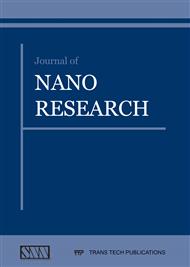[1]
R. S. Scott, N. A. Dumin, T. W. Hughes, D. J. Dumin, B. T. Moore, Properties of High-Voltage Stress Generated Traps in Thin Silicon, IEEE Trans. Elect. Dev. 43 (1996)1133-1143.
DOI: 10.1109/16.502425
Google Scholar
[2]
FarhanRana, SandipTiwari, J. J. Welser, Kinetic Modelling of Electron Tunneling Processes in Quantum Dots Coupled to Field-Effect Transistors AP J. Superlattices Microstructures. 23 (1998) 757-770.
DOI: 10.1006/spmi.1997.0539
Google Scholar
[3]
C. MonzioCompagnoni, D. Ielmini, A. S. Spinellit, A. L. Lacaita, C. Previtali, C. Gerardi, Study of Data Retention for Nanocrystal Flash Memories, Proc. IEEE 41st Annual lnt. Symp. on Reliability Physics. (2003) 507-512.
DOI: 10.1109/relphy.2003.1197800
Google Scholar
[4]
M. Depas, B. Vermeire, P. W. Mertens, R. L. Van Meirhaeghe, M. M. Heyns, Determination of Tunnelling Parameters in Ultra-thin Oxide Layer Poly-Si/SiO2/Si Structures, Elsevier J. Solid-State Electronics. 38 (1995)1465-1471.
DOI: 10.1016/0038-1101(94)00269-l
Google Scholar
[5]
Jonghwan Lee, GijsBosman, Keith R. Green, D. Ladwig, Model and Analysis of Gate Leakage Current inUltrathin Nitrided Oxide MOSFETs, IEEE Trans. Electron. Dev. 49 (2002)1232-1241.
DOI: 10.1109/ted.2002.1013281
Google Scholar
[6]
Dong-Won Kim, Taehoon Kim, Sanjay K. Banerjee, Memory Characterization of SiGe Quantum Dot Flash Memories With HfO2/SiO2 Tunneling Dielectrics, IEEE Trans. Electron. Dev. 50 (2003)1823-1829.
DOI: 10.1109/ted.2003.815370
Google Scholar
[7]
F. Jimenez-Molinos, F. Gamiz, A. Palma, P. Cartujo, J. A. Lo, Direct and Trap-Assisted Elastic Tunneling through Ultrathin Gate Oxides, J. Appl. Phy. 91 (2002)5116-5124.
DOI: 10.1063/1.1461062
Google Scholar
[8]
Tuo-Hung Hou, Jaegoo Lee, Jonathan T Shaw, Edwin C Kan, Flash Memory Scaling: From Material Selection to Performance Improvement (2007) www. researchgate. net.
Google Scholar
[9]
Barbara De Salvo, CosimoGerardi, Rob van Schaijk, Salvatore A. Lombardo, DomenicoCorso, Cristina Plantamura, Stella Serafino, Giuseppe Ammendola, Michiel van Duuren, Pierre Goarin, Wan Yuet Mei, Kees van der Jeugd, Thierry Baron, Marc Gély, Pierre Mur, Simon Deleonibus, Performance and Reliability Features of Advanced Nonvolatile Memories Based on Discrete Traps (Silicon Nanocrystals, SONOS), IEEE Trans. Dev. Mat. Rel. 4 (2004).
DOI: 10.1109/tdmr.2004.837209
Google Scholar
[10]
International Technology Roadmap for Semiconductors (ITRS) (2013) http: /www. itrs. net.
Google Scholar
[11]
Robin Degraeve, Guido Groeseneken, Rudi Bellens, Jean Luc Ogier, MichelDepas, Philippe J. Roussel, Herman E. Maes, New Insights in the Relation between Electron Trap Generation and theStatistical Properties of Oxide Breakdown, IEEE Trans. Electron Dev. 45 (1998).
DOI: 10.1109/16.662800
Google Scholar
[12]
E. H. Nicollean and J. R. Brews, MOS (Metal Oxide Semiconductor) Physics and Technology, Wiley-Inderscience Publication, (1982).
Google Scholar
[13]
W. R. Thurber, R. L. Mattis, Y. M. Liu, and J. J. Filliben: National Bureau of Standards Special Publication (1981) 400-464.
Google Scholar
[14]
W. C. Lee, C. Hu, Modeling Gate and Substrate Currents due to Conduction-and-Valence-Band Electron and Hole Tunneling, IEEE Dig. VLSI Tech. (2000) 198-199.
DOI: 10.1109/vlsit.2000.852824
Google Scholar


